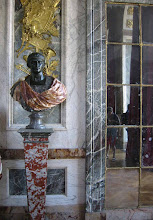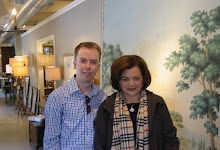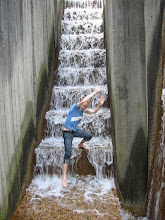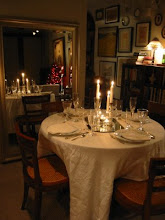 Last weekend I toured Fallingwater, the famous Frank Lloyd Wright designed country house for Edgar J. Kaufmann, Sr while in Western Pennsylvania.
Last weekend I toured Fallingwater, the famous Frank Lloyd Wright designed country house for Edgar J. Kaufmann, Sr while in Western Pennsylvania.  This is the famous view as seen from across the waterfall. I hadn't visited in a few years and was hit again by how modern this house really is: hard to believe it was designed in 1934.
This is the famous view as seen from across the waterfall. I hadn't visited in a few years and was hit again by how modern this house really is: hard to believe it was designed in 1934.  Edgar Kaufmann Jr. was studying with Frank LLoyd Wright (a low point of FLW's career where he taught to make ends meet) and convinced his parents to hire him to build a country house on their land in Bear Run, PA. The highlight of the land was a beautiful waterfall and Wright ingeniously recommended building ON the falls rather than facing them (the common approach).
Edgar Kaufmann Jr. was studying with Frank LLoyd Wright (a low point of FLW's career where he taught to make ends meet) and convinced his parents to hire him to build a country house on their land in Bear Run, PA. The highlight of the land was a beautiful waterfall and Wright ingeniously recommended building ON the falls rather than facing them (the common approach).  The Kaufmann's would escape here with friends or alone for years: lots of parties and drama, trust me! The commission revived Frank Lloyd Wright's career, even making the cover of Time magazine shortly after it was completed. Not bad for a private country house!
The Kaufmann's would escape here with friends or alone for years: lots of parties and drama, trust me! The commission revived Frank Lloyd Wright's career, even making the cover of Time magazine shortly after it was completed. Not bad for a private country house! The living room connects you to the outside in many ways. You can hear the falls situated right right underneath, as seen below. The natural stone walls and flooring also connect you to the site as do the large open expanses of windows.
The living room connects you to the outside in many ways. You can hear the falls situated right right underneath, as seen below. The natural stone walls and flooring also connect you to the site as do the large open expanses of windows. Numerous seating areas in this large entertaining space make for a great party room. The house is much smaller than you would think, about 2,500 sf, and this is the only public space. A very modern idea which many of us have in our own homes, one room for living room, den & dining room.
Numerous seating areas in this large entertaining space make for a great party room. The house is much smaller than you would think, about 2,500 sf, and this is the only public space. A very modern idea which many of us have in our own homes, one room for living room, den & dining room. The Kaufmann's must have really kept Tiffany's in business. The house is littered with beautiful objects such as these bowls on the low tables in the sitting area.
The Kaufmann's must have really kept Tiffany's in business. The house is littered with beautiful objects such as these bowls on the low tables in the sitting area. Unfortunately, an overly zealous maid had attacked them with a brillo pad, scrubbing the gilding off!
Unfortunately, an overly zealous maid had attacked them with a brillo pad, scrubbing the gilding off! The falls are connected to the living room directly with a set of stairs which take you down to the stream right before the waterfall. The windows telescope back allowing access.
The falls are connected to the living room directly with a set of stairs which take you down to the stream right before the waterfall. The windows telescope back allowing access. One of the nicest features is that the house is set up as if the Kaufmann's might walk in at any moment with many personal items and fresh flowers in every room.
One of the nicest features is that the house is set up as if the Kaufmann's might walk in at any moment with many personal items and fresh flowers in every room.  As air conditioning was rare in 1934, cross ventilation was extremely important, even in the mountains of Pennsylvania. In the guest room on the 2nd floor, these small windows are located above the bed along with a large wall of glass facing south.
As air conditioning was rare in 1934, cross ventilation was extremely important, even in the mountains of Pennsylvania. In the guest room on the 2nd floor, these small windows are located above the bed along with a large wall of glass facing south. Even Mrs. Kaufmann's bathroom is set up as if in use: much of this beautiful glass is from lalique. Extraordinary! Love the planters screening the bathroom from the master bedroom's terrace.
Even Mrs. Kaufmann's bathroom is set up as if in use: much of this beautiful glass is from lalique. Extraordinary! Love the planters screening the bathroom from the master bedroom's terrace. More Tiffany pieces on Mrs. Kaufmann's dressing table.
More Tiffany pieces on Mrs. Kaufmann's dressing table. The lamp seen here on Mr. Kaufmann's nightstand is located throughout the house and was designed by FLW for the house. They're available for purchase in the giftshop: I was so tempted!!
The lamp seen here on Mr. Kaufmann's nightstand is located throughout the house and was designed by FLW for the house. They're available for purchase in the giftshop: I was so tempted!! Mr. Kaufmann's desk in his bedroom (yes, seperate his and her bedrooms) had fresh flowers and a Tiffany inkwell: the most important thing to note is the notch in the desk to allow the window to open bringing in the sound of the falls.
Mr. Kaufmann's desk in his bedroom (yes, seperate his and her bedrooms) had fresh flowers and a Tiffany inkwell: the most important thing to note is the notch in the desk to allow the window to open bringing in the sound of the falls. One of the most noted features of the home are the linen shelves with reeding to allow air to circulate: I wish I had this at home!
One of the most noted features of the home are the linen shelves with reeding to allow air to circulate: I wish I had this at home! Mrs. Kaufmann sadly committed suicide here at the house but her memory lives on. Besides being buried here with her husband, this photo of her with fresh flowers lies in her son's 3rd floor bedroom.
Mrs. Kaufmann sadly committed suicide here at the house but her memory lives on. Besides being buried here with her husband, this photo of her with fresh flowers lies in her son's 3rd floor bedroom. My favorite part of the house is probably the ascent to the guest house, built a few years after the house which contains additional guest & servant quarters along with a carport.
My favorite part of the house is probably the ascent to the guest house, built a few years after the house which contains additional guest & servant quarters along with a carport. The path of stairs is covered with this cantilevered roof which is really breathtaking: A true structural feat!
The path of stairs is covered with this cantilevered roof which is really breathtaking: A true structural feat! The guest sitting room is really comfortable and as beautiful as the main house. One bonus feature is the taller ceiling! Additional guests could sleep on the built in sofa along the window wall as well as in the guest bedroom next door which housed many famous luminaries of the day, including Einstein.
The guest sitting room is really comfortable and as beautiful as the main house. One bonus feature is the taller ceiling! Additional guests could sleep on the built in sofa along the window wall as well as in the guest bedroom next door which housed many famous luminaries of the day, including Einstein.
Edgar Kaufmann, Jr realized the importance of this house and donated it to the Western Pennsylvania Conservancy in October, 1963 after his parents deaths. He remained an active supporter of the museum till his death when his ashes were strewn over the grounds, near his parents.


 Blown away not just by the sumptuousness of every detail: the gilding, the beautiful mirror, the huge crowds, but mainly by the beautiful light.
Blown away not just by the sumptuousness of every detail: the gilding, the beautiful mirror, the huge crowds, but mainly by the beautiful light. The room is immensely long, 239.5' to be exact, and that doesn't include the adjoining Salon of War and the Salon of Peace on either end.
The room is immensely long, 239.5' to be exact, and that doesn't include the adjoining Salon of War and the Salon of Peace on either end.














 Many things on the property bare the name Clayton. The name is derived from Henry CLAY Frick: The 'ton' relates to the word town.
Many things on the property bare the name Clayton. The name is derived from Henry CLAY Frick: The 'ton' relates to the word town. Part of the carriagehouse.
Part of the carriagehouse. The playhouse was built for the children and is the size of a normal house. It held rooms for the children's toys as well as a bowling alley! Lucky kids! It now holds the giftshop: this is where you will start your tour.
The playhouse was built for the children and is the size of a normal house. It held rooms for the children's toys as well as a bowling alley! Lucky kids! It now holds the giftshop: this is where you will start your tour. The conservatory lies next door.
The conservatory lies next door. Across the walkway is an old caretakers cottage which now houses a pretty great restaurant. We didn't get a chance to eat here but I highly recommend it based on past experiences.
Across the walkway is an old caretakers cottage which now houses a pretty great restaurant. We didn't get a chance to eat here but I highly recommend it based on past experiences.
 The main house was renovated after the Frick's purchase of a typical Victorian which they renovated into a gracious family home. The only original piece left was the porte cochere seen here below an amazing stained glass & copper bay.
The main house was renovated after the Frick's purchase of a typical Victorian which they renovated into a gracious family home. The only original piece left was the porte cochere seen here below an amazing stained glass & copper bay. A closeup of the port cochere columns.
A closeup of the port cochere columns. A shot of the backdoor to end the tour. If you find yourself in Pittsburgh, don't forget to visit, the interiors are spectacular!
A shot of the backdoor to end the tour. If you find yourself in Pittsburgh, don't forget to visit, the interiors are spectacular! Three house tours in three days. This past weekend I spent 'camping' with some friends in Western Pennsylvania on the grounds of
Three house tours in three days. This past weekend I spent 'camping' with some friends in Western Pennsylvania on the grounds of 
 Having roots from the area may bias me, but I think Western Pennsylvania in the fall is the most beautiful place on earth. Above, a charming church in Ohiopyle.
Having roots from the area may bias me, but I think Western Pennsylvania in the fall is the most beautiful place on earth. Above, a charming church in Ohiopyle.
 The field behind our house was a meadow filled with wildflowers and views over the surrounding hills. Each night we had these amazing sunsets which I tried to capture here in photographs to no avail.
The field behind our house was a meadow filled with wildflowers and views over the surrounding hills. Each night we had these amazing sunsets which I tried to capture here in photographs to no avail. I say 'cabin' loosely, it was actually a house from the 1960s which used to belong to the lawyers of the Kaufmann Family.
I say 'cabin' loosely, it was actually a house from the 1960s which used to belong to the lawyers of the Kaufmann Family.





















.jpg)





















.JPG)






































































